Planning tool for welfare culling during farm disrupted operations
When cull animal markets are disrupted, on-farm euthanasia of these animals based on welfare may have to be considered.

When large meat processors are forced to close their doors due to employee sickness, the impact can be felt throughout the supply chain. Farmers who normally supply these markets are left with few options, often turning to small-scale meat processing operations. Many smaller processors are not equipped with the resources to absorb higher volumes of production. Limitations such as structural restrictions, fewer staff, limited capital and the lack of necessary equipment to operate such large volumes are often a challenge for smaller businesses. As a result, many livestock suppliers have nowhere to go with their livestock. Without an outlet for the supply, farmers may experience situations where alternative options are needed for their livestock. Michigan State University Extension has supplied some potential options for livestock producers in Supply chain disruptions, the first article of this three-part article series that describe methods to potentially implement before euthanasia is considered, realizing euthanasia may be the only option as a last resort.
The current disruption in animal agriculture due to the COVID-19 pandemic may lead to reduced or suspended access to certain resources, particularly on dairy farms. For example, some markets for cull cattle have slowed down or temporally closed limiting the ability to send livestock to markets. The information provided in this article is derived primarily from industry sources and government agencies. This resource has been assembled to assist the animal agriculture industry in weathering difficult times. Please note that Michigan State University Extension does not advocate, endorse or suggest any course of conduct that may be covered in these guidance materials, which are purely for informational purposes given under disruptive circumstances caused by the COVID-19 pandemic.
The goal of this planning tool is to offer suggestions to farmers and stockpersons during reduced or suspended access to resources. Farms need to discuss and work with their stockpersons, employees and herd veterinarian to implement emergency operation plans. Communication with customers and stakeholders is critical.
Alternatives to on-farm culling
Drying off dairy cows early that are in good health but have low productivity or reproduction efficiency, is one alternative to culling. If your farm is experiencing labor disturbances in milking or hauling milk, drying off cows early could decrease the labor associated with milking, allow the cows to gain weight for better carcass return at a lower feed cost, and will decrease the farm’s milk supply. Small, local processing facilities may be a possibility for voluntary healthy cull cows; however, these facilities are unlikely to take involuntary, sick or injured cull cattle.
In a disrupted market, the transport time of cull cows to auctions or slaughter facilities could increase significantly, including transport between multiple collection points. This, in turn, reduces the animals’ value further while the costs for transport, feed and labor increase. It can also negatively impact animal welfare if that animal is not fit for a longer transport experience.
MSU Extension suggests managing the impact of disrupted markets on farms by:
- retaining human safety and health through protocols for personnel biosecurity and well-being, including telemedicine or counseling as appropriate
- slowing the growth of livestock using lower-cost feedstuffs
- diverting animals to additional space such as alternative holding facilities, open fields, or grazing around the property to reduce pressure on markets
- reducing the number of less viable animals to markets
- stopping or altering breeding
- reassessing herd health plans to accommodate restricted stockperson availability
- developing a protocol for welfare culling by defining which livestock should be euthanized and when
- updating training of all stockpersons on planned and welfare mortality using humane euthanasia
Humane on-farm culling
Euthanasia, derived from two Greek terms meaning ‘good’ and ‘death,’ enables stockpersons to end the life of an animal humanely. Planned mortality is defined as the decision to euthanize livestock due to a lack of market or to reduce animal suffering. Welfare culling includes reducing the inventory of animals that either will not recover from injury or illness, despite treatment; or when housing space or other resources are constrained.
Administering welfare culling in disrupted times demonstrates compassion for the life of the animal by reducing poor welfare outcomes. MSU Extension acknowledges that euthanizing animals has an important impact on the humans involved in the process. It is not uncommon for those who participate in the euthanasia of animals to show signs of mental illness. Those experiencing stress and mental health issues as a result of being involved in euthanasia can access free online counseling.
As part of good animal welfare, the American Association of Bovine Practitioners recommends farmers should not transport ambulatory animals that will not pass pre-slaughter inspection at a packing or processing plant. These conditions include: cancer eye, blindness in both eyes, fever greater than 103 degrees Fahrenheit, drug residues, peritonitis, fractures or lameness (4 or 5 on a 5-point scale), unreduced prolapses, cows that are calving or have a high likelihood of calving during transport, suspected central nervous system signs, or open wounds.
When crises and disruption do not allow cattle to be move from the farm, welfare culling is a strategy to alleviate pressure on limited resources such as feed and space. Welfare culling only utilizes humane euthanasia methods. Based on the current Guidelines of the American Veterinary Medical Association, the only acceptable methods for on-farm euthanasia of cattle include:
- Gunshot or free bullet - the most common method of euthanasia for cattle. Basic recommendations include using a solid point bullet to avoid overpenetration and ricochet. The rifle should be fired within 1-3 feet of the cow’s skull into the proper anatomic location.
- Penetrating captive bolt (PCB) - has the advantage of humane euthanasia, low cost of ammunition, and improved human safety. For large farms, the initial capital costs of the PCB can be amortized relatively fast while also needing less expensive ammunition and carrying fewer safety hazards to humans. This method requires to be followed by an adjunct method such as a second shot or exsanguination.
- Injection with barbiturates has the advantage of a humane death and must be administered by a licensed veterinarian. The animal carcass must be disposed of correctly to avoid secondary poisoning to wildlife.
Regardless of the method or ultimate reasoning, the goal is to induce a humane death, with minimal pain and distress to the animal. When properly used by skilled personnel with well-maintained equipment, physical methods of euthanasia, such as gunshot using firearms or a penetrating captive bolt, can reduce animal fear and anxiety and be rapid, painless, practical, and humane. To ensure both a humane death and human safety, only people who are trained should perform euthanasia. Animals should be appropriately restrained to reduce the likelihood of a missed shot and prevent human injury.
As mentioned, euthanizing livestock during a crisis or market disruptions can profoundly impact a farmer's mental well-being, especially when healthy animals must be culled through euthanasia. The concept of the caring-killing paradox describes when animal caregivers must sometimes euthanize the same healthy or compromised animals for which they have been providing care. However, despite this emotional fatigue, many animal caretakers can acknowledge and justify their actions by realizing that euthanasia may relieve animal suffering.
The stockperson responsible for euthanasia should have both the training and caring attitudes. A survey found that stockpersons who received in-person training were more willing to euthanize a compromised animal than those who only read the literature. Inexperienced persons can gain proficiency in performing the method correctly, humanely and with safety by training on euthanized animals, normal mortality, or through in-person training. One of the most critical factors in humane euthanasia is to use the most effective firearm and captive bolt method, followed by confirmation of death. Farmers need to provide protocols with timely decision-making and consistency of euthanasia recommendations. Below, farmers will find guidance and instruction to assist farmers and stockpersons on animal considerations, human concerns, selection and application of a method, and assurances of a humane death.
Reasons for on-farm euthanasia include animals that:
- are unlikely to recover
- fail to respond to treatment and convalescent protocols within two days of treatment
- have chronic, severe or debilitating pain and distress
- have an acute, severe injury
- are experiencing uncorrectable calving distress
- are unable to get to or consume feed and water (non-ambulatory)
- show rapid weight loss or emaciation
- will suffer in transit if sent to stockyards or direct to slaughter
Practical methods of euthanasia
Firearms - For many farms, the use of a firearm and a free bullet (as opposed to the captive bolt) is acceptable and the most practical method of euthanasia. The goal for euthanasia using a single shot is for the ammunition (bullet or shotshell) to penetrate and damage the brain. The success of this single shot is dependent on the accuracy of the shot and type of firearm and ballistics used. Due to the hazards to humans, euthanasia using firearms should only be performed by highly skilled personnel trained in their use, and only in jurisdictions that allow for legal firearm use. The goal of on-farm welfare culling is euthanasia using a single shot. Other areas for consideration when using firearms include:
- Properly restrain the animal. In cows, tying or holding a halter to a gate or the animal’s rear limb provides adequate restrain of the animal.
- Establish a ricochet free zone and absorb the bullet in the event of overpenetration:
- clear people from the shooting area
- position a 3/4 inch, 84 foot piece of plywood behind the cow to absorb any unintended ammunitions.
- Aim the end of the barrel of the gun 1 to 2 feet from the animal’s forehead perpendicular to the skull and in line with the intended trajectory (Figure 1). This will ensure that the projectile enters the brain and causes an instant loss of consciousness.
- Never hold the gun barrel flush on an animals’ head because the pressure many cause the gun barrel to explode.
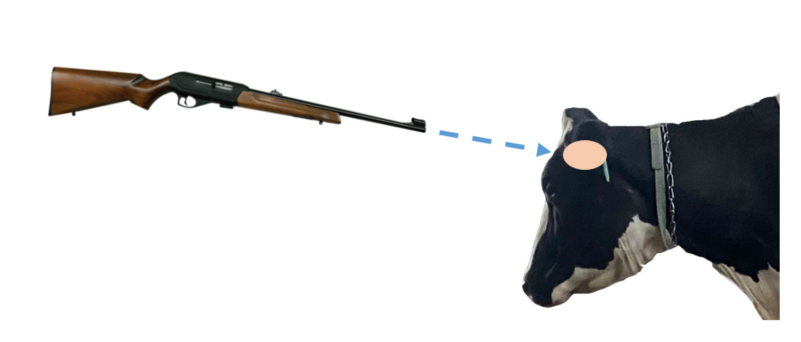
- The destructive capacity of the ammunition is measured in muzzle energy.
- The required muzzle energy for larger animals is 1,000 ft-lb.
- Avoid the use of handguns, as they do generally not reach the correct muzzle energy for cattle euthanasia.
- All firearms require planning for an adjunct method, such as a second shot or exsanguination.
- The following firearms and ammunitions are the most appropriate and safest to use:
- Shotguns such as 12, 16, 20 gauge can be used on all weights of animals.
- Shotguns are best used within 3-6 feet distance from the animal’s forehead.
- Birdshot (shotgun shells number 4, 5, and 6) are acceptable when used in close range (3 feet) as the birdshot starts to disperse as it leaves the gun barrel
- Slugs (special shotgun shells) are considered the best ammunition because it is a solid mass and does not disperse.
- Rifles such as .22 magnum and higher-powered rifles (.243, .270) are appropriate for heifers, cows, and bulls.
- The .22 rifle (100 ft-lb energy) should never be used on adult cattle.
- A .308 rifle at short range is too powerful and likely causing the ammunition to over-penetrate. A .308 should only be used for long-range shots.
- For human safety and humane euthanasia, the best rifle ammunition should be a solid point bullet.
- Do not use hollow point ammunition as it may not cause enough physical brain damage.
- Do not use full metal jackets as that may result in overpenetration.
- All other persons should be evacuated to behind the shooter.
- Always have a backup gun (firearm or penetrating captive bolt) ready to rotate firearms if there are many animals to be euthanized.
- Note that while cattle slaughter plants use less powerful firearms such as .22 rifle and hollow point bullet, the aim of a slaughter plant is both human safety and to stun the animal, followed by exsanguination.
Penetrating captive bolt (PCB) - PCBs are also an acceptable humane euthanasia method. It causes physical damage to the brain due to concussive force and sufficient brain disruption due to projectile penetration of the bolt and fragments from the skull plate (Figure 2).
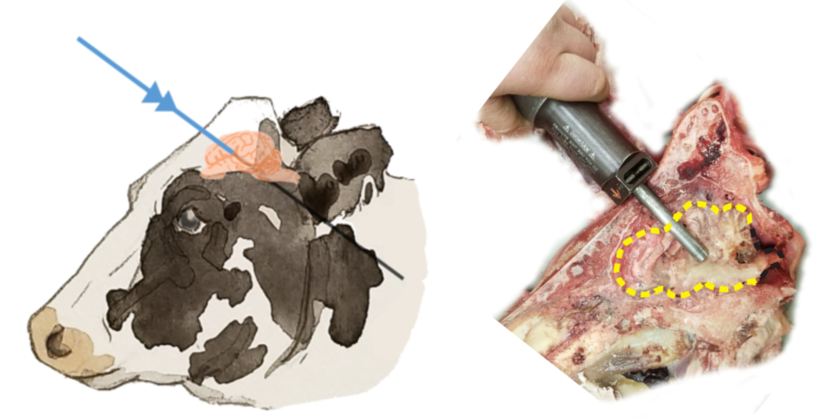
There are two types of PCB: pneumatic powered and gun powder-charge activated. The latter is commonly used on farms and smaller slaughter plants. In this article, we will only discuss gun powder-activated PCBs.
Unless a powerful PCB designed for euthanasia is used, PCB may require a secondary step to ensure death. Given that the goal for on-farm euthanasia is single-step euthanasia, MSU Extension recommends the use of PCBs of sufficient bolt length and force. The bolt length at penetration should be between 4-5 inches, and the bolt flight velocity should be between 190 feet per second and 250 feet per second. If the gun is well maintained and the correct grain is used according to manufacturer’s recommendations, a 0.25 caliber free flight (in-line) captive bolt gun will generally meet these specifications. While MSU Extension does not endorse specific commercial products, examples of PCB guns suppliers and contacts include Schermer and Jarvis.
PCBs consist of a steel bolt restrained within the barrel of the gun. On firing, the powder charge expands the gas within the gas end and propels the pistons forward and forcing the bolt forward. The flange and cushions absorb the energy released by the charge and hold the bolt in the barrel. After firing, the bolt is retracted manually or automatically into the barrel. Powder-activated captive bolt guns are available in .22 caliber, and .25 caliber and the length of bolt varies between manufacturers. It is essential to follow the manufacturer’s recommendations regarding cartridge grains of powder for each animal type to be euthanized. For adult cattle, the Humane Slaughter Association recommends 3.0-4.0 grain charge.
Factors to consider when using PCBs for on-farm euthanasia include animal restraint, accurate placement, force velocity delivered to the head, bolt penetration depth and correct cartridge size for size and age of the intended animal(s) must be considered:
- Adequate animal restraint is important to ensure proper placement of captive bolts. It will improve accurate placement over the ideal anatomic site (Figure 3). The energy (i.e., bolt velocity) and depth of penetration of the bolt determine the effectiveness of the device to cause a loss of consciousness and death. Both concussive force and energy to penetrate the skull are needed for the effective use of the PCB. Bolt velocity will be affected by PCB maintenance and cleaning, as well as appropriate storage of the cartridge charges. Hence, PCB must be cleaned following manufacturer’s instructions every day that the PCB has been fired.
- Low energy results in concussive force to disrupt the brain stem, but lack of skull penetration to cause sufficient cortical brain damage.
- Too high an energy results in a skull penetration but little concussive effect.
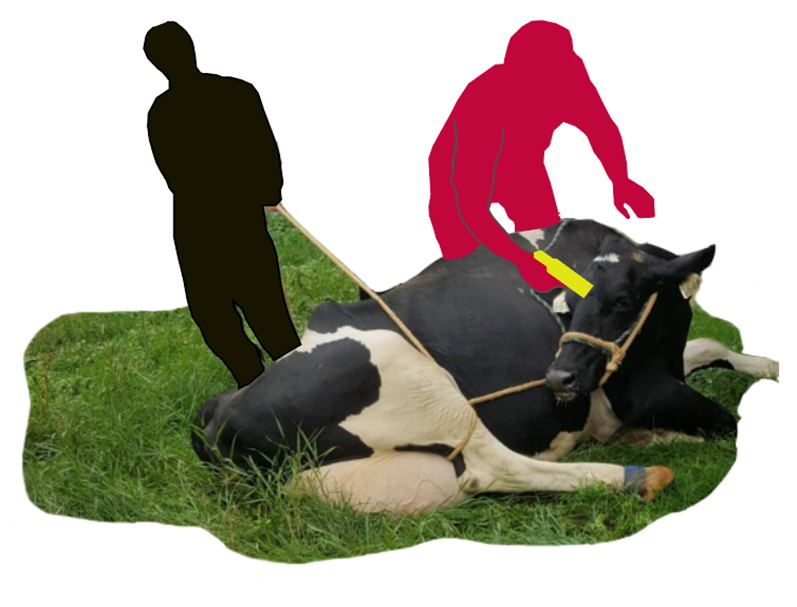
- Signs of effective captive bolt penetration and death are immediate collapse and a several-second period of tetanic spasm, followed by slow hind limb movements of increasing frequency.
- Once the shot is taken, step away to avoid kicks made due to tonic/clonic (spasms) actions
- To ensure the death of the animal, a secondary step would be needed unless a powerful PCB is used. While a second shot with a firearm or pithing are approved secondary methods, their practicality for on-farm euthanasia when using PCBs is limited. Therefore, exsanguination following PCB shooting is recommended as the most practical secondary method in this setting. To produce exsanguination, use a knife to incise at the level of the neck to ensure that the jugular vein and carotid artery are cut. Figure 4 depicts the location of these vessels along the neck of a cow.
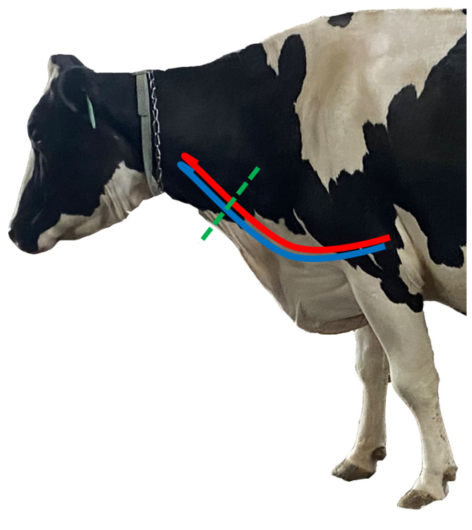
Location of the brain
When using a firearm or a PCB, the projectile must reach the brain to ensure euthanasia. Hence, operators must be able to use anatomic landmarks to localize the brain and aim the discharge. The point of entry of the projectile should be at the intersection of 2 imaginary lines, each drawn from the outside corner of the eye to the center of the base of the opposite horn (Figure 6). Never shoot between the eyes.
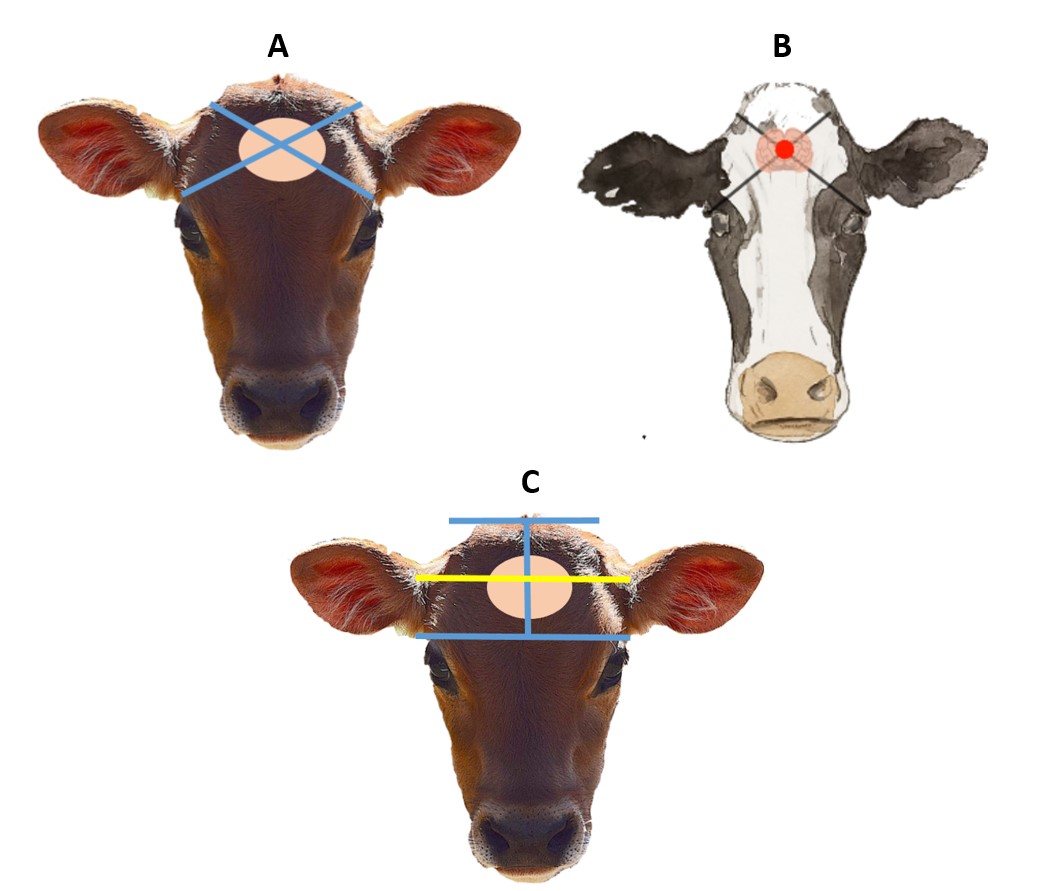
Confirmation of death
Humane euthanasia includes the confirmation of death for every animal. This is an important issue for both the animal and assurances for the stockperson. It would be grievous to find an animal believed to be euthanized that was actually still alive. After euthanizing an animal, the operator must always test for insensibility and death. Dairy Australia recommends checking all these five signs:
- Lack of corneal reflex -check by tapping the inner eye to see if the animal responds.
- Pupils are unresponsive to light
- Flaccid Jaw
- Flaccid Tongue
- No heartbeat or respiration for 5 minutes. The animal will have random breathing and heartbeat. Make sure both are absent for 5 minutes.
To learn more about proper mortality management after humane euthanasia is performed, please visit article three of this series, In times of supply chain disruption, how do I appropriately dispose of my livestock mortalities?



 Print
Print Email
Email
